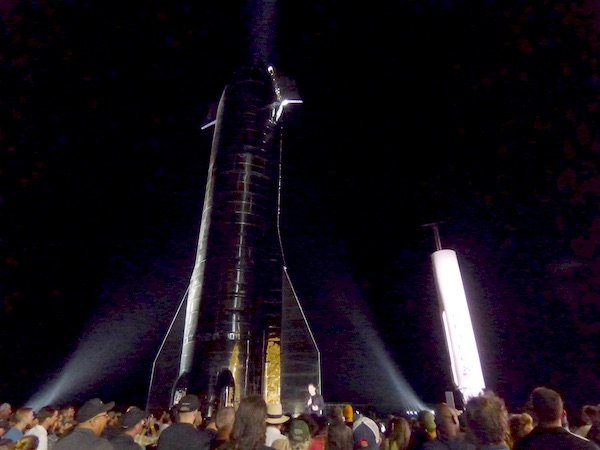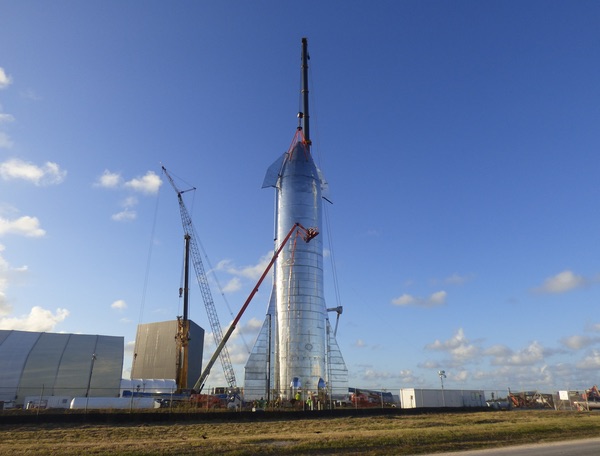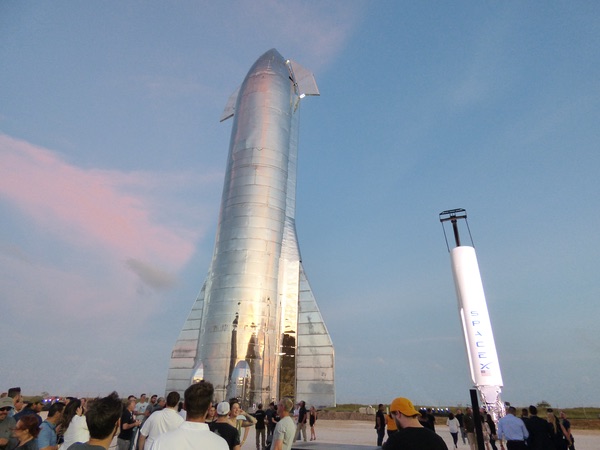Starships are meant to flyby Jeff Foust
|
| “The best design decision on this whole thing is 301 stainless steel,” Musk said. |
A year later, Musk returned to the IAC, this time in Australia, to discuss the vehicle, now known as BFR (formally Big Falcon Rocket, although the “F” had another meaning, of course.) The event lacked the chaos, or the questions, of the 2016 event, as Musk described how they had made the vehicle somewhat smaller, yet still able to place 150 metric tons into orbit or even be used for point-to-point passenger transportation (see “Mars mission sequels”, The Space Review, October 2, 2017.)
Last year, Musk eschewed the IAC for SpaceX’s own factory in California. The vehicle was still called the BFR, but with tweaks to its design. It now had a customer: Japanese billionaire Yusaku Maezawa, who said he planned to charter a BFR flight around the Moon in 2023, carrying a group of artists for a project called “#dearMoon” (see “SpaceX’s BFR gets closer to Mars, by way of the Moon”, The Space Review, September 24, 2018.)
This year, Musk came to the company’s test site in South Texas, near Boca Chica Beach east of Brownsville, to provide an update September 28. Five years ago, Musk was here to break ground on what was then planned to be a spaceport for Falcon 9 and Falcon Heavy rockets (see “A highway’s ending is a spaceport’s beginning”, The Space Review, September 29, 2014). Now, the location is both a development and launch site for that next-generation system, which has changed names again: the upper stage is called Starship, and the booster Super Heavy.
In past events, Musk had animations of Interplanetary Transport System/BFR, along with videos of Raptor engine tests and images of hardware being built and tested. This time, he had a vehicle itself: the Starship Mark 1 prototype, assembled in recent months at Boca Chica and its two halves brought together just the day before. Towering 50 meters over the crowd of media, employees, and other guests, the Starship’s stainless steel exterior reflected the soft light of sunset. By the time Musk arrived to speak, night had fallen, and the Starship took on a ghostlier appearance, its sci-fi rocketship shape outlined by backlit floodlights.
While Musk had used past events to announce updates in the design of the vehicle, the biggest design changes in the last year had come out months earlier, including the decision last fall to switch to a version of stainless steel called type 301 rather than use carbon composite materials, as previously planned. Musk argued, both months earlier and at this weekend’s presentation in Boca Chica, that steel, counterintuitively, was lighter than carbon composites given the conditions the vehicle would experience.
“The best design decision on this whole thing is 301 stainless steel,” he said. “At cryogenic temperatures, 301 stainless actually has about the same effective strength as an advanced composite or aluminum-lithium.”
At high temperatures, that stainless steel performs much better than composites. “For a reusable ship, you’re coming in like a meteor. You do not want something that melts at a low temperature,” he said. “This is where steel is extremely good as well.”
| “I think we should really do our very best to become a multiplanet species and to extend consciousness beyond Earth,” Musk said, “and we should do it now.” |
That high temperature, he said, eliminates the need for thermal protection shielding on the “leeward” side of the vehicle, which faces up during reentry, and is “massively reduced” on the windward side that bears the brunt of heating during reentry. That shielding is in the form of hexagonal tiles made of “basically tiny glass vermicelli,” as he put it, that are light but crack-resistant. “The net effect is that a 301 stainless steel rocket is actually the lightest possible reusable architecture.”
Switching to steel offers another benefit: reduced cost. Carbon fiber costs $130,000 per ton, he said, versus $2,500 per ton for type 301 stainless steel. “It’s a good thing we changed from carbon fiber to steel, by far.”
But that switch from carbon composites to steel took place months ago, and Musk had explained much of that in tweet-sized blurbs since then, often responding to questions from others on Twitter. There was little new about other technical aspects of the vehicle, like the Raptor engine: Musk showed a video of a lengthy Raptor test, but said little else about the development and production of the engine.
Indeed, much of the 40-minute talk seemed like a bit of a rehash of past presentations: emphasizing the importance of reusability to lower launch costs and SpaceX’s own history with reusability. That included the Falcon 1, which made its first successful orbital launch exactly 11 years earlier; the company had a Falcon 1 first stage on display as Musk discussed unsuccessful efforts to recover the stage by parachute.
There was also the obligatory reminder of the importance of making humanity a multiplanetary species, including settling Mars. “I think we should really do our very best to become a multiplanet species and to extend consciousness beyond Earth,” he said at the end of his presentation, “and we should do it now.”
 Elon Musk (bottom center) is barely visible on stage at the event, dwarfed by the giant Starship Mark 1 behind him. (credit: J. Foust) |
Accelerating production
That SpaceX had the Starship Mark 1 ready—or, at least, its main sections assembled into a single vehicle—was little surprise: the company had clearly been working towards that for a while, its outdoor assembly activities in plain view of anyone who passed by the site on Texas Highway 4. In Florida, a second Starship prototype, Mark 2, has been under construction for the last few months at a former steel yard in Cocoa, not far from Cape Canaveral.
Musk, in his presentation and the question-and-answer session with reporters that followed, made it clear he intended to move quickly, starting with a suborbital test flight of the Mark 1 vehicle. “This thing is going to take off, fly to 65,000 feet, about 20 kilometers, and come back and land, in about one or two months,” he announced at the event.
After that, he suggested, might be a flight directly to orbit, which would require producing both a Super Heavy booster as well as new “Mark 3” version of Starship, construction of which would begin within a month at Boca Chica. (Later in the same answer, he suggested it might be a Mark 4 or Mark 5 vehicle that makes the first orbital flight.)
| “The rate at which we will be building ships is going to be quite crazy by space standards.” |
He made it clear, though, that Starship prototypes would be built, both in Texas and Florida, at a rapid clip. “We are going to be building ships and boosters at both Boca and the Cape as fast as we can,” he said. “We’re improving both the design and the manufacturing method exponentially.”
That means finishing Mark 2 within a couple of months, with Mark 3 in “maybe three months.” (Keep in mind construction of Mark 3 hasn’t started yet.) “Mark 4: four months, maybe five months,” he said. “The rate at which we will be building ships is going to be quite crazy by space standards.”
“And this is going to sound totally nuts, but I think we want to try to reach orbit in less than six months,” he said. “Provided the rate of design improvement and manufacturing improvement continues to be exponential, I think that is accurate to within a few months.”
Musk, or course, is infamous for what he has admitted are “aspirational” schedules, which the company often misses. Given that the Mark 1 has yet to fly, believing that a future Starship will reach orbit in six or even nine months might be the poster child for aspirational schedules.
 Workers put the finishing touches on Starship the day before the SpaceX event. The rocket, being built next to Highway 4, is visible for miles in the coastal plains of South Texas. (credit: J. Foust) |
Regulation and perception
Even if the vehicles are ready, though, there are other obstacles to deal with, notably regulatory. This summer, SpaceX proposed a test flight for a smaller prototype called Starhopper, where the vehicle would fly to an altitude of 200 meters above a pad at Boca Chica before descending to a landing at a neighboring pad. The vehicle had already performed a brief hover flight just above the pad, but the hazard analysis required by the FAA’s Office of Commercial Space Transportation delayed the test to late August. Ultimately, the FAA approved an amendment to Starhopper’s existing experimental permit, allowing just a single flight to 150 meters, and with the company’s insurance requirement soaring from $3 million to $100 million. (The test flight was a success, and SpaceX now plans to use Starhopper as a test stand for static firing Raptor engines.)
But while Starhopper, powered by a single Raptor, went to just 150 meters, SpaceX envisions flying Starship to at least 20,000 meters with three-engine configuration: a larger, more energetic vehicle, with likely a more complicated hazard analysis. Musk, though, sounded optimistic about getting the needed regulatory approvals.
“The FAA asks good questions and wants to make sure things are safe, as do we,” he said. “I feel pretty optimistic about things. I don’t see any fundamental obstacles.” However, he didn’t state how far along he was in the process of getting either a new experimental permit, which the FAA has up to 120 days to review applications for, or a full-fledged launch license, which has a 180-day review period.
| “Commercial Crew is years behind schedule,” Bridenstine said. “NASA expects to see the same level of enthusiasm focused on the investments of the American taxpayer. It’s time to deliver.” |
There is also a question of perceptions. While Musk and SpaceX talk about accelerating work on Starship, efforts in other areas appear to lag. That’s particularly the case for Crew Dragon, which is years behind its original schedule and suffered a setback in April when the spacecraft that flew the uncrewed Demo-1 test flight in March was destroyed during preparations for a static-fire test of its abort thrusters.
NASA administrator Jim Bridenstine made waves with sharp criticism of SpaceX a day before the announcement. “I am looking forward to the SpaceX announcement tomorrow,” he said in a statement he tweeted. “In the meantime, Commercial Crew is years behind schedule. NASA expects to see the same level of enthusiasm focused on the investments of the American taxpayer. It’s time to deliver.”
Defenders of SpaceX noted that Boeing is also behind on its commercial crew vehicle, the CST-100 Starliner, while NASA is lagging on both the Space Launch System and Orion. But none of those efforts have the similar perceived distractions that Starship is for Crew Dragon.
Musk, asked about Bridenstine’s comments, said Starship is not a major drain on SpaceX, using, he said, less than five percent of the company’s resources. “Our resources are overwhelmingly on Falcon and Dragon,” he said.
Yet, SpaceX is also talking about accelerating construction of Starship vehicles (and also, he said, flying people on them as soon as next year, although he offered few details about the development of life support systems for Starship needed for such flights.) If SpaceX can speed up work of a giant vehicle, what’s slowing down Crew Dragon: different technologies, NASA paperwork, or something else? Might SpaceX have already gotten bored of Crew Dragon, distracted by, quite literally, a shiny new object?
SpaceX would likely argue that’s not the case, and NASA hopes that’s true. A year from now, when Musk makes another Starship update—maybe this time in Florida, or perhaps Boca Chica again, or even back at the IAC, which will be in the UAE in 2020—the company certainly expects Starship will be, at the very least, flying to the edge of space, if not in orbit. NASA also expects to see Crew Dragon in orbit by this time next year.
Note: we are temporarily moderating all comments subcommitted to deal with a surge in spam.
